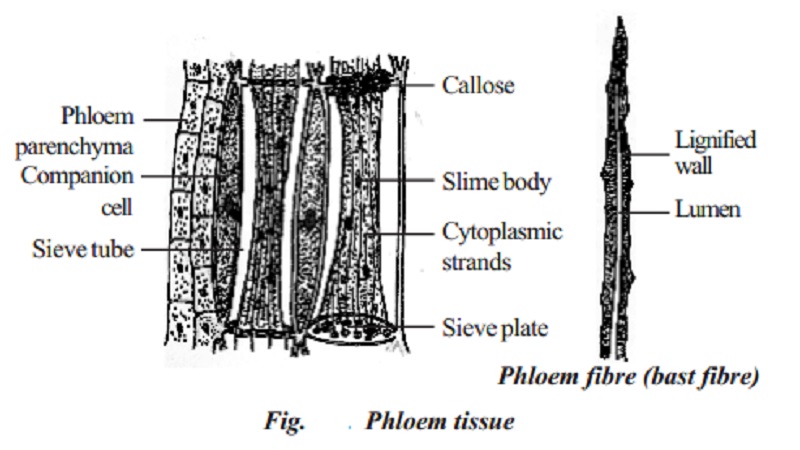Chapter: 11 th 12th std standard Bio Botany plant tree Biology Higher secondary school College Notes
Phloem : Sieve elements, Companion cells, Phloem parenchyma, Phloem fibres

Phloem
Like xylem, phloem is also a complex tissue. It conducts food materials to various parts of the plant. The phloem elements which are formed from the procambium of apical meristem are called primary phloem. The phloem elements which are produced by the vascular cambium are called secondary phloem. The primary phloem elements that develop first from the procambium are smaller in size called the protophloem, whereas those develop later are larger in size called metaphloem. The protophloem is short lived. It is crushed by the developing metaphloem.
Phloem is composed of four kinds of cells: sieve elements, companion cells,phloem parenchyma and phloem fibres. Companion cells are present only in angiosperms. Companion cells are absent in pteridophytes and gymnosperms. Phloem fibres are absent in the primary phloem of most of the angiosperms. But they are usually present in the secondary phloem.
Sieve elements
Sieve elements are the conducting elements of the phloem. They have thick primary walls. Their end walls are transverse or oblique. The end wall contains a number of pores and it looks like a sieve. So it is called a sieve plate.The sieve elements are arranged one above the other and form vertical sieve tubes. In matured sieve tube, nucleus is absent. It contains
a lining layer of cytoplasm. This is an important feature of sieve elements. A special protein called slime body is seen in it. The conduction of food material takes place through cytoplasmic strands. They are distinguished into sieve cells and sieve tubes.Sieve cells occur in pteridophytes and gymnosperms, while sieve tubes occur in angiosperms.
Sieve cells have sieve areas on their lateral walls only and are not arranged one above the other in linear rows. They are not associated with companion cells. Sieve tubes are arranged one above the other in linear rows and have sieve plates on their end walls. They are associated with the companion cells. In mature sieve elements, sometimes the pores in the sieve plate are blocked by a substance called callose.
Companion cells
The thin-walled, elongated, specialised parenchyma cells, which are associated with the sieve elements, are called companion cells. In contrast to sieve elements, the companion cells have cytoplasm and a prominent nucleus. They are connected to the sieve tubes through pits found in the lateral walls. The companion cells are present only in angiosperms and absent in gymnosperms and pteridophytes. They assist the sieve tubes in the conduction of food materials.
Phloem parenchyma
The parenchyma cells associated with the phloem are called phloem parenchyma. These are living cells. They store starch and fats. They also contain resins and tannins in some plants. They are present in all , pteridophytes, gymnosperms and dicots. In monocots, usually phloem parenchyma is absent.
Phloem fibres
The fibres of sclerenchyma associated with phloem are called phloem fibres or bast fibres. They are narrow, vertically elongated cells with very thick walls and a small lumen (the cell cavity). Among the four kinds of phloem elements, phloem fibres are the only dead tissue. These are the strengthening and supporting cells.
The tissue system
A group of tissues performing a similar function irrespective of its position in the plant body is called a tissue system. In 1875, Sachs recognized three tissue systems in the plants. They are epidermal tissue system, vascular tissue system and fundamental tissue system.
Related Topics